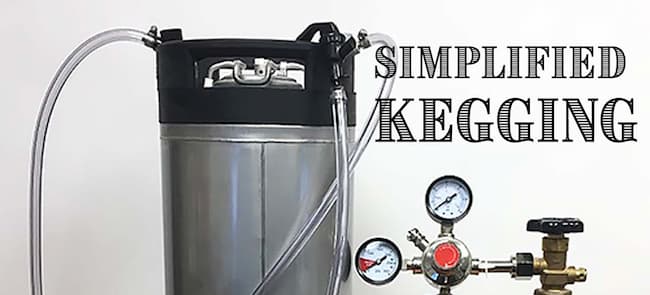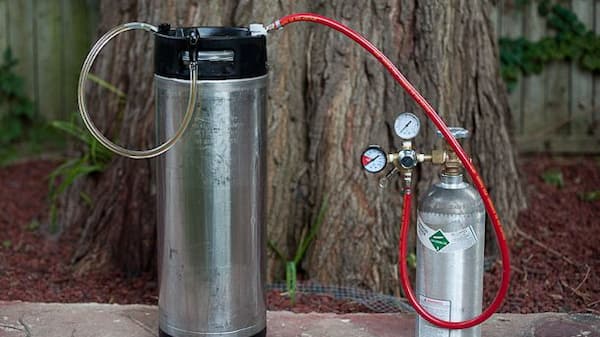Do you love beer? Have you ever wanted to make your own? Now, with this step-by-step guide on how to keg your own beer, you can keg your own beer right at home! Kegs are a great way to store and serve your homebrewed beer. They also make it easy to transport your brew to parties and other events.

In this guide, we will walk you through the process of how to keg your own beer. Let’s get started!
How To Keg Your Own Beer?
Brewing ingredients for 5 gallons of beer, enough to make 2 cases (64 oz) bottles for how to keg your own beer. For a list of the ingredients and instructions on how to make your own homebrew, 5-gallon soda keg (empty).

Ingredients For Kegging The Beer
- Siphon hose and auto-siphon for moving the beer from the fermenter to the keg.
- 5 pound CO2 tank. You can also purchase these in disposable 12 or 20 oz. cartridges that screw into the regulator.
- 15 feet 3/16″ beer line to connect the keg to the regulator.
- A few hose clamps.
- Sanitizer.
- Socket Wrench.
- Beer faucet to dispense the beer.
- Wine thief for measuring the beer and plug for attaching it to the keg.
- Bottle capper for sealing the bottles.
- Hydrometer for measuring the gravity of your beer.
- Brewer’s best friend — a homebrew recipe kit containing malt extract, hops, yeast, and priming sugar. There are
Process To Keg Your Own Beer
- The first step is to sanitize the keg, the lid, all of its fittings, and anything else that will come in contact with your beer. This is best done by soaking everything in a boiling water bath for at least 10 minutes, although some people prefer to use a no-rinse sanitizer, also how many calories in a corona beer. Soak the keg itself in water and then add your solution to that, too. Use boiling water if you are using a No-Rinse Sanitizer (such as StarSan).
- Now it’s time to transfer your fermented wort into the keg. First, gently pour your beer into the keg through the opening at the top. Next, attach your lid with either an airlock hole or a rubber plug (if you don’t have an airlock). You can use some sort of clamp to attach it tightly. Fill another keg (or another vessel) with clean water and pressurize it to around 20 PSI.
- Pour this water back and forth between the kegs until you’ve transferred most of your beer out of its original container. Ideally, you want to transfer it into the new keg in one swift motion, this minimizes oxidation. You can also use CO 2 to expel the air from the headspace of the keg, or suck it out with a straw.
- Now that the beer is in the keg, pressurize it to around 15 PSI and attach the lid with either an airlock hole or rubber plug (if you don’t have an airlock). Store it somewhere cool for two weeks while fermentation finishes. If you want to expedite this process, you can chill your keg in a freezer.
- When you’re ready for some cold and delicious homebrew, carbonate the beer to around 2-3 PSI and then attach either the pressure release valve (for beers that need less fizz) or an airlock (for beers requiring more fizz). Place the keg at around 40-50 degrees for two weeks.
- Now you have your own delicious homebrew! Kegs are a convenient way to store and serve your beer, plus they make for great conversation starters.
Disclaimer: I am not responsible for any injuries sustained while attempting this process. This guide is intended to instruct on homebrewing procedures only and does not cover safety precautions on how to keg your own beer. If you are uncertain about the safety or quality of your keg setup, please consult a professional brewery or brewery supply retailer.
Extra Tips
- If you aren’t able to get your hands on a food-grade keg or don’t want to spend the money for one, the cheapest and most effective way to keg your homebrew is by using a 5-gallon soda keg. You will need to make sure the keg has never held anything other than soda, though.
- Bring your keg to a local store that sells them for deposits (most stores that sell new kegs charge a deposit). You can find out how much your local store charges by calling or stopping by.
- When you return the keg, you will be refunded your deposit. I was able to get my $80 deposit back when I returned my 5-gallon soda keg.
- Sanitizer Sources: Star San (no rinse) Powdered Brewery Wash (PBW) Straight-A Soap Iodophor Sanitizer
- Alcohol Sources: Grain Alcohol (Everclear) Potable/Drinking Alcohol (Safbrew S-33 or Westvleteren 12)
- You should be able to find these products at your local homebrew store or online.
- Kegging Sources: Cornelius Kegs Five Gallon Pin Lock Kegs Five Gallon Ball Lock Kegs
- You should be able to find these products at your local homebrew store or online. These are affiliate links that help support this blog on how to keg your own beer, I appreciate it!
- Carbonator Cap Sources: Carbonator Caps on Amazon.
Also Check: Best way to clean beer glasses
Conclusion
I hope I’ve been able to convince you on how to keg your own beer of the joys of kegging your homebrew. It’s simple, clean, and convenient. Plus, it makes for great conversation when you flip open the keg to show your friends and family, see our chillbeer for more. Cheers!